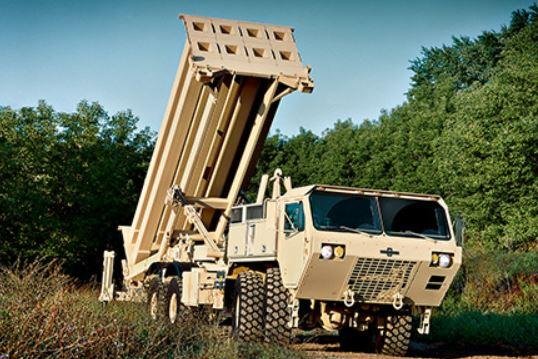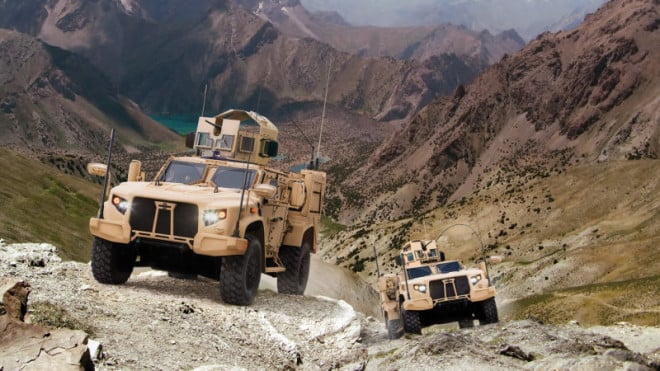The Oshkosh Corporation (formerly known as Oshkosh Truck, and even before that as the Four Wheel Drive Auto Company) is a manufacturing company that engineers and constructs a wide array of specialty vehicles. Dating back to 1906, the company has contributed impressive products to society and the military from Oshkosh, WI. The Four Wheel Drive Auto Company is credited with the second four-wheel drive vehicle ever constructed in the United States. After starting out as a manufacturer of small four-wheel drive trucks, they grew into the Fortune 500 juggernaut they are today. They have done so in part due to their business with the military, building tough, high quality trucks for their rugged demands.
The Origins
In 1906, two partners of a machine shop in Clintonville, WI, William Besserdich and Otto Zachow, took a ride in their car, the first motor vehicle to ever be purchased and operated on the area. They traveled to a town called Embarrass, about four and a half miles away. On their way however, their car got stuck in a sandy patch on the road. The men and their passengers used the front spokes of the front wheels for leverage in order to rescue their beloved machine, while Besserdich hit the gas. It was then that Besserdich realized that it was much easier to get the vehicle free by “powering” all four wheels. This sparked the idea to invent a mechanism to build a vehicle system to supply power to all four wheels.
After convincing his partner of his idea, the two began designing. On March 24, 1908, the two filed and were granted a patent on their “Otto Zachow and W.A. Besserdich Axle” and thus the Four Wheel Drive Auto Company was born[8]. Over the next few years, they would continue to improve their design, and although it was very successful, the two could not find the proper funding needed to continue manufacturing. In 1917, the Chamber of Commerce in Oshkosh offered to help them, if they moved and formed a new company in Oshkosh. This new business was therefore named the Oshkosh Motor Truck Co. The plant has since been located in Oshkosh, building heavy duty four-wheel drive trucks. After branching out and expanding their company, their reputation grained traction, Enough to warrant these high quality, high performance machines to be build for the United States Armed Forces. They did not appear to in the military scene, however, until World War II.
Impact During World War II
Oshkosh first got into military affairs in 1939, when they supplied Model W-700 trucks to the Air Corps. These trucks were specifically designed for snow removal at Army Air Corps bases. With the ability to plow and dump in the dead of winter, these trucks were used to keep the runways clear in order for aircraft to takeoff. These inventions were top of the line, boasting “more comfort, power and efficiency” [3]. Oshkosh built various trucks throughout World War II in addition to snow removal vehicles, including firefighting, construction, and transportation trucks. The W-1600 model truck was designed with three axels in order to conquer off-road terrain in oil fields and also carrying heavy trailer payloads, such as arms, ammunition and other supplies. Other vehicles, such as the W709-C-T-5 Tractor constructed for the navy, were used for transporting aircraft. The company was recognized in 1945 by the Army and Navy, receiving the Excellence in Wartime award, also known as the “E” award. The award description details making “a single award to individual plants which have achieved outstanding performance on war production” (history.navy.mil). This is a prestigious award, as only 5% of all manufacturing plants in the country that contributed products to the war effort received the E award during the World War II.
Cold War Contributions
.jpg)
After the conclusion of World War II, Oshkosh Truck continued doing business with the military. They first received contracts to design and build new WT-2206’s. This was an improved, tougher, larger, and faster snow plowing vehicle. It was utilized at Air Force bases, like its predecessor. Though not appreciated as so, these machines were crucial in the security of the United States during the Cold War. They were extremely important towards the operation of the Distant Early Warning (DEW) system set up by the government. This system was a multitude of radar stations located across the northern U.S. and Canada. These radar lines were installed in order to identify any incoming threat during the Cold War, such as Soviet bombing attacks, or any land or sea invasion. WT-2206’s cleared the runways at an unheard of speed at that point in time. The plows could clear the runways at 55mph. They also were able to make a 180 degree turn in order to come back in the opposite direction, while other typical vehicles were unable to, constraining them to return where they started to make a second pass. Time is a critical factor when dealing with incoming enemy threats. Any time that was able to be saved would have made a significant impact.
The Gulf War

In August 1990, the Gulf War broke out in the Middle East. The leader of Iraq, Saddam Hussein, invaded Kuwait over a demand for $10 billion in lost revenues. Unsatisfied with Kuwait’s counter offer, Iraq didn’t hesitate to act. Soon after, the United Nations requested the Iraqi forces to retreat and leave Kuwait. Refusing to budge, Iraq was given a set date to fall back by, or the coalition would remove them by force. The United States got involved in the situation, and sent in troops for operation Desert Shield.
During the war, there were many issues with supply routes, due to the harsh environment. Vast, sandy, rocky terrain gave commercial utility cargo vehicles (CUCVs) nightmares. A large portion of these units were very old and warn out. This produced continuous breakdowns and need of repair. That is where Oshkosh stepped in. New heavy expanded mobility tactical trucks, or HEMTTs, were supplied to the area. [1]. These eight-wheel drive monsters made the life of transporting goods and materials across the vigorous terrain much easier, as they are capable of driving up a 60-degree incline. These trucks even came in a variety of configurations. One of these types is are cargo variants for moving heavy equipment, most likely stockpiles of ammunition. Tankers carry up to 2,500 gallons of fuel to replenish other vehicles. Wrecker configurations, also called recovery trucks, were used to recover disabled vehicles in the field using a heavy duty crane and winch.
HEMTTs can also be designed specifically for guided missile transportation (GMT). This configuration played an important role in ballistic missile defense. These GMTs were tasked with carrying out devices for the Patriot mission. The Iraqi forces launched many scuds (Iraqi ballistic missiles) at neighboring Israel and Saudi Arabia throughout the Gulf War. The Patriot Surface-to-Air missile system (SAM) was the first attempt to intercept incoming short range missiles (Tucker). Although the results are controversial, it is widely accepted that initial success rates approached 70% in Saudi Arabia. These feats were all accomplished due in part from Oshkosh’s state-of-the-art technologies.

Oshkosh Corporation Today
Oshkosh Corporation is still continuing to be a world leading manufacturing company. In August 2015, Oshkosh’s next generation Joint Light Tactical Vehicle (JLTV) program was awarded a contract to supply the United States military with a possibility of up to almost 17,000 trucks. These vehicles are yet again revolutionizing the protection and mobility of the United States Military. The JLTV uses their own Oshkosh Tak-4i independent suspension system. This highly advanced system has allowed for arguably unbeatable off road performance. It allows for 20 inches of wheel movement, making boulders feel like pebbles. The improved wheel travel also tolerates up to 70% faster off-road speeds than today’s gold standard [3]. Even the bumpiest of paths feel like an average street while riding.
The impressive list of features on the Joint Light Tactical Vehicle includes a heating system that can increase the internal temperature from -40°F, to 65°F within an hour. The air conditioning also reduces the temperature down from 120°F to 90°F. There are characteristics for emergency situations, as safety is the number one factor that is kept in mind while being designed. The doors have jam resistant doors in order for the occupants to escape from the vehicle in case of an emergency. Built in, is an automatic fire extinguishing system to minimize damage to the soldiers inside, and also to the vehicle itself. The system can sense a fire and put it out within 10 seconds.
Other features of the JLTV include protection, and durability. JLTVs can be equipped with two different armor “kits”. Kit-A has some armor, but is limited in that fact. There is a separate kit-B that can be installed on site. The advantage of this is reducing the load on the vehicle, preventing excess wear and tear and extending its life span. Kit-B can be installed in the field within 5 hours, so it can be prepped the day of a potential conflict. Even the paint used on the JLTVs are engineered to increase the life of the truck. It has polyfibroblast, which is self-regenerating. Before the steel can begin to corrode, the paint forms over the scratches, which also enhances the operating lifetime.
Oshkosh Corporation has progressed a long way since being established over 100 years ago. From stumbling upon a brilliant idea for general advancement of motorized vehicles in the early 1900s, to paving the way, making the impossible to cross terrain conquerable. They have lived up to, and look to continue to their mission, “to partner with customers to deliver superior solutions that safely and efficiently move people and materials at work, around the globe and around the clock” [3].
Primary Sources
- Scales, Brigadier General Robert H, (1993) Certain Victory: The US Army in the Gulf War.
- Menard, James, (2013, Jan 8). Oshkosh Defense Delivers 100,000th Military Vehicle.
- OshkoshDefense.com, (2016, Sept 26). US Army Places $42 Million Order for the Joint Light Tactical Vehicle Program.
Secondary Sources:
- Fundinguniverse.com. Oshkosh Truck Corporation History.
- Military1.com (2013, Jan 8). Oshkosh Defense Delivers 100,000th Military Vehicle.
- Kepos, P., & Thomson Gale (Firm). (1993). International directory of company histories: Volume 7. Detroit, Mich: St. James Press.
- Business Wire (2004, Mar 24). Oshkosh Truck Wins Phase I Marine Corps Truck Contract.
- Clarence “Inky” Jungwirth. (2004). Tales of Oshkosh, Volume 5. Oshkosh Public Library.
- Military.com, Heavy Expanded Mobility Tactical Truck
- Tucker, Spencer C., (1991), Persian Gulf War Encyclopedia: A Political, Social, and Military History.
Further Reading:
- Oshkoshcorp.com. Company History an Interactive Timeline.
- Oshkoshairport.com. 1917. The Dawn of the Oshkosh Legacy.

